P1379
TWEEN® 20
viscous liquid
Synonym(s):
Polyethylene glycol sorbitan monolaurate, Polyoxyethylenesorbitan monolaurate
About This Item
Recommended Products
description
non-ionic
Quality Level
Assay
>40% (GC)
form
viscous liquid
mol wt
~1228
composition
lauric acid, ≥40% (balance primarily myristic, palmitic, and stearic acids)
concentration
≥40.0% (GC)
technique(s)
DNA extraction: suitable
RNA extraction: suitable
cell culture | mammalian: suitable
protein purification: suitable
impurities
≤3.0% water
refractive index
n20/D 1.468 (lit.)
CMC
0.06 mM (20-25°C)
acid number
≤2.2 mg/g
hydroxyl value
96‑108 mg/g
transition temp
cloud point 76 °C
density
1.095 g/mL at 25 °C (lit.)
HLB
16.7
suitability
complies for IR spectroscopy
SMILES string
CCCCCCCCCCCC(=O)OCCOCC(C1C(C(CO1)OCCO)OCCO)OCCO
InChI
1S/C26H50O10/c1-2-3-4-5-6-7-8-9-10-11-24(30)34-19-18-31-20-22(32-15-12-27)26-25(35-17-14-29)23(21-36-26)33-16-13-28/h22-23,25-29H,2-21H2,1H3
InChI key
HMFKFHLTUCJZJO-UHFFFAOYSA-N
Looking for similar products? Visit Product Comparison Guide
General description
Surfactants, possessing both hydrophilic and hydrophobic components, fall into two main categories: ionic, which ionize in water (anionic, cationic, or ampholytic), and nonionic, which do not ionize. The discussed product is a nonionic surfactant with diverse applications such as emulsification, dispersion, solubilization, and detergent use. Additionally, it can serve as a solubilizer for membrane proteins.
Application
- washing buffer and blocking buffer in Western blotting
- blocking buffer in immunohistochemistry
- washing buffer in ELISA (enzyme linked immunosorbent assay)
- reaction mixture in PCR (polymerase chain reaction)
TWEEN 20 has been used as a blocking agent for membrane based immunoassays at a typical concentration of 0.05%. TWEEN 20 can be used for lysing mammalian cells at a concentration of 0.005 to 0.5%.
Features and Benefits
- Highly versatile surfactant for your life science and biochemical research
- Excellent solubilising, dispersing and emulsifying agent
- Suitable for DNA & RNA extraction, mammalian cell culture, and protein purification
Packaging
Each kit contains 3 x 100ML samples, each sample from a uniquely manufactured lot.
Preparation Note
Other Notes
Legal Information
also commonly purchased with this product
comparable product
recommended
Storage Class Code
10 - Combustible liquids
WGK
WGK 3
Flash Point(F)
527.0 °F - Pensky-Martens closed cup
Flash Point(C)
275 °C - Pensky-Martens closed cup
Personal Protective Equipment
Choose from one of the most recent versions:
Certificates of Analysis (COA)
Don't see the Right Version?
If you require a particular version, you can look up a specific certificate by the Lot or Batch number.
Already Own This Product?
Find documentation for the products that you have recently purchased in the Document Library.
Customers Also Viewed
Articles
Available Fluorescent in situ hybridization (FISH) procedures, reagents and equipment.
Available Fluorescent in situ hybridization (FISH) procedures, reagents and equipment.
Available Fluorescent in situ hybridization (FISH) procedures, reagents and equipment.
Available Fluorescent in situ hybridization (FISH) procedures, reagents and equipment.
Protocols
This page shows how to solubilize membrane proteins with products from Cytiva.
Related Content
Find solutions for bulk production, custom packaging, and personalized chemical services to meet your unique research, development, and manufacturing requirements in your industries, including pharmaceuticals, biotechnology, and research institutions.
Our team of scientists has experience in all areas of research including Life Science, Material Science, Chemical Synthesis, Chromatography, Analytical and many others.
Contact Technical Service





